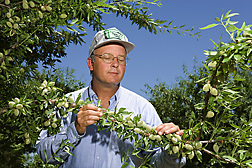This page has been archived and is being provided for reference purposes only. The page is no longer being updated, and therefore, links on the page may be invalid.
|
Read the magazine story to find out more. |
|
|
|
|
ARS Scientists Develop Self-pollinating Almond Trees
By Alfredo FloresApril 6, 2010
Self-pollinating almond trees that can produce a bountiful harvest without insect pollination are being developed by Agricultural Research Service (ARS) scientists. This is good news for almond growers who face rising costs for insect pollination because of nationwide shortages of honey bees due to Colony Collapse Disorder (CCD) and other factors.
ARS geneticist Craig Ledbetter, at the agency’s Crop Diseases, Pests and Genetics Research Unit near Parlier, Calif., is developing this new line of self-pollinating almond trees.
Self-pollinating almonds are not new. The Tuono variety, originally from Spain, has been around for centuries. But its traits are not attractive when compared to California’s most popular almond, Nonpareil.
Tuono’s seed coat has a hairy texture and it has a very thick shell, so only 32 percent of the nut is edible kernel, compared to 60 to 65 percent for Nonpareil. But Tuono’s thick shell gives it more resistance to the navel orangeworm and other pests. An almond that has traits from both varieties would be ideal.
Ledbetter and his collaborators used Tuono as the male (pollen) parent in conventional hybridizations with California-adapted almond cultivars and selections. The scientists made crosses at bloom time and came back at harvest time to collect the nuts. They then grew those nuts into seedlings and surrounded the branches with insect-proof nylon bags to exclude insects that could serve as pollinators. The seedlings bloomed and some produced fruits inside the bags, making these seedlings self-pollinating.
The original plantings in 1996 at first produced only small harvests, but by 2006 produced excellent results. In November 2008, after a very good almond harvest, Ledbetter and his team from Parlier brought eight very promising selections from his self-pollinating almond breeding program to the Almond Board of California for evaluation.
The board was pleased with the skin color, oil content and, most importantly, the flavor. And best of all, the new almonds have many of the same characteristics as Nonpareil, which sells for premium prices.
Read more about this research in the April 2010 issue of Agricultural Research magazine.
ARS is the principal intramural scientific research agency of the U.S. Department of Agriculture (USDA). The research supports the USDA priority of promoting international food security.

